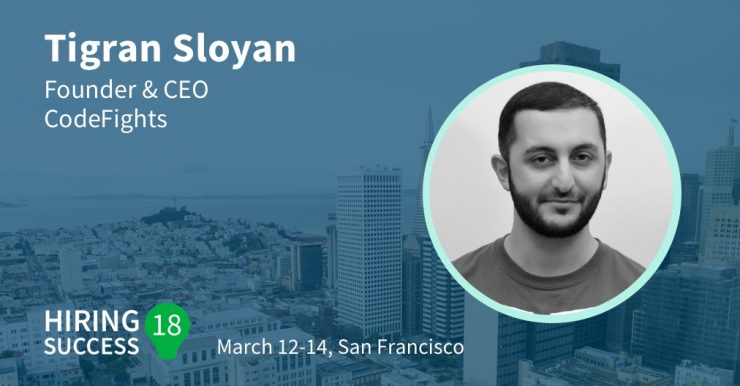Looking to improve your coding, find a job, and have fun all at the same time? Well, a Bay Area CEO and founder has the tool for you: CodeFights.
Founded in 2014 by Tigran Sloyan, CodeFights is the startup behind an addictive game which allows coders to test their skills and connect to employers quickly, easily and, perhaps most revolutionary of all, enjoyably. It’s designed to be used by coders of all levels, meaning if you’re a newbie hoping to get into the industry, or a veteran looking to hone their skills and prove their worth, CodeFights could be for you.
Sounds like a good idea, right? A lot of coders would agree. Since launching, CodeFights now boasts a community of over one million developers in 200 countries.
Of course, Tigran’s idea doesn’t just end at a fun coding distraction. He realizes CodeFights also presents a huge opportunity to employers looking to hire in a competitive business. A candidate’s resume and CV might tell you about their previous work experience, but how can you quickly and effectively test their skills at scale? CodeFights adds a level of practical assessment to your recruiting process.
Tigran is one of the HR visionaries we are proud to invite to this year’s Hiring Success 18 conference, San Francisco March 12th – 14th. You’ll need to register to attend his ‘Measuring Talent’ session, although you can enjoy some preliminary insights in the interview below:
What does the concept of Hiring Success mean to you?
I believe hiring great people is the most important predictor of a company’s success. The secret is always in the right execution, not the idea.
Where on your list of priorities is “recruitment”?
It’s always my number-one priority.
Who was/is your biggest professional influence and why?
I am a big fan of CEO books, and have been reading books by, or about some, of the most influential CEOs. From Steve Jobs to Elon Musk and Jack Ma — I have pretty much read them all. But the CEO I admire the most is Jeff Bezos. He has the ability to focus and execute flawlessly, while planning almost 10 years ahead in his strategic decisions.
What do you think will be the defining feature of recruitment in five years? How will it look?
Data. I believe recruiting is a classic marketplace problem. The reason no one’s built an Uber for Recruiting yet is that matchmaking is incredibly hard in this marketplace. The only thing that can make it possible with a high degree of accuracy is data. So I believe in the next five years we will see companies emerge that have very high-quality data about both jobs and candidates, enabling it to create a truly liquid talent marketplace.
What inspired you to combine gamification and coding in CodeFights?
I am a big believer that doing almost anything can be fun if it’s designed the right way. And first and foremost, learning and professional development MUST be fun. For more details, please see here.
How do you see the concept expanding beyond coding and recruitment?
The core technology behind CodeFights can quantify programming skills and automatically measure them. That enables us to create an engaging environment in which developers can practice for technical interviews, as well as give companies the tools they need to recruit qualified talent. This core tech can be extended to pretty much every objectively measurable skill, and the same model can be copy-pasted to those other verticals.
What advice would you give an employer thinking of adding an assessment layer to their recruitment process?
The most important part of adding an assessment layer is measuring the right skills. It’s not that hard to create some sort of an assessment layer, but if that assessment layer measures skills that aren’t relevant to the job, the whole process after that will be a waste of everyone’s time.
What will the emergence of new technologies mean for the average hiring manager? What will their day look like?
It will be far more efficient. These days hiring is a guessing game. No one knows who’s interested in what kind of opportunities and no one knows who’s qualified for which job. Once both of those problems are solved, you can spend far less time connecting with candidates that aren’t a good fit, and focus your attention on recruiting those few highly qualified candidates. After all, the art of recruiting is about convincing candidates that the job you’re offering them is the best possible choice. It’s not about spamming, and it’s not about keywords based matching.











